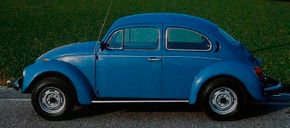1980-1997 Volkwagen Beetle
The 1980-1997 Volkswagen Beetle became an unlikely instrument of national politics and a lever for social uplift. If it was failing in America against new rivals, there were places in which it was staying true to its original mission as a "people's car."
As Volkswagen moved into the 1980s, its plants in Brazil and Mexico were turning out 250,000 Volkswagen Beetles each year for local consumption and for export. The latter included CKD (complete knock-down) kits for assembly in countries like Costa Rica, Nigeria, Portugal, Peru, and Thailand.
Advertisement
For a time, Mexico supplied cars to satisfy residual demand in Germany. Fittingly, its final such shipment was made in August 1985, almost 40 years since Major Ivan Hirst's ramshackle little colony set up in the bombed-out chaos of Wolfsburg.
Mexico was also the sole source for the Volkswagen Beetle-based Type 181 of 1970-1976, a stark, square Kubelwagen-style open four-door originally developed for the German military and known in America as "The Thing."
In 1985, Volkswagen estimated that some eight million Beetles still traveled the world's roads, a million in Germany alone. The next year, though, Beetle production was halted in Brazil as that nation struggled with hard times fueled by triple-digit inflation; that also ended most CKD operations.
Then, in 1993, Brazilian president Itamar Franco ordered production resumed. Like Adolf Hitler, he saw the cheap, cheerful Fusca (as the Beetle was known there) as a way to curry public favor and provide needed jobs. Mildly updated, the Fusca lasted through 1996, by which time sales had again plunged in a strongly revived economy.
In Mexico, too, the Beetle became an instrument of national politics and social uplift. There, in 1992, the government dangled a contract for a "popular" car before all the local automakers, which included Chrysler, Ford, General Motors, and Nissan.
Volkswagen won by agreeing to sell its Vocho (Mexican Beetle) for just $6,500, a 20-percent cut. Though output initially ran some 140,000 per year, it declined through the late 1990s to about 60,200. But that was enough, and the 21-millionth Beetle chugged forth from Puebla in June 1992.
The Vocho was by then as much a part of Mexican life as mariachi bands and tequila, and demand seemed sufficient to keep the car alive indefinitely. By 1998, in fact, the Vocho accounted for fully 20 percent of Mexico's vehicle population and 80 percent of Mexico City taxis (which, sadly, also accounted for most of the capital's choking smog).
Though Puebla had become a modern, highly automated factory, Volkswagen Beetle production remained labor-intensive, so Volkswagen earned no money on Vochos at the government-mandated selling price. But the Volkswagen Beetle also remained an "image-puller" for newer VW models, and VW Mexico wouldn't abandon the country's cheapest car. Mexicans wouldn't let them anyway.
As the Los Angeles Times noted in March 1998, the Vocho is "pure, functional transport with the advantage of . . . basic technology and dead-simple repairs." Even drugstores carried accessories, and as one enthusiast said, a Vocho could be fixed with just "a wire and a Chiclet." As ever, the Volkswagen Beetle was easy to love and tough to kill.
The Beetle had thus come full circle after some 60 eventful years. It revived Germany after World War II, made import cars a worldwide phenomenon, and introduced Americans to the idea of high-quality cars at any price. It had raced up mountains, become a dune buggy for the beach, been personified in movies (Disney's Love Bug series), and adopted as a social statement.
Through its first six decades, the Beetle had stayed true to its original mission of basic transportation for common folk everywhere. But Volkswagen had a new Beetle on the way, and in more ways than one, the Bug was headed for an about-face.
Though the Volkswagen Beetle's days had ended in the U.S. and it was no longer being built in Germany, it continued to be produced in Brazil. What came off the line was a standard Beetle (not a Super Beetle). Ferdinand Piech, grandson of Ferdinand Porsche, moved up through the ranks at Audi, Volkswagen's partner, finally becoming chief of Volkswagen itself in 1993.

For more great articles and pictures on new and classic Volkswagens, see:
- Volkswagen Beetle
- New Volkswagen Prices and Reviews
- Used Volkswagen Prices and Reviews
